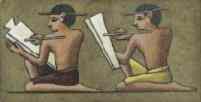AscendingPassage.com
See the: Egyptian Secrets Library.

The Temple of Soleb
Built just south of the Third Nile Cataract, by Pharaoh Amenhotep III (18th Dynasty, ruled 1390-1352 BC) in honor of the god Amun-Re and to Nebmaatre - which was simply another name for Pharaoh Amenhotep as Lord of Nubia. Soleb (Sulb, Solib) temple was over 400 feet long, and the entire enclosure was about 700 by 800 feet. Today foundations and a few columns remain. Two red granite lions from Soleb are now in the British Museum.

Soleb, lithograph by Ernst Weidenbach, 1845

Soleb
by George A. Hoskins, 1835
Edited excerpt from: Travels in Nubia
by John Lewis Burckhardt
Published in 1819.
March 15th, 1813.
Instead of proceeding across the desert to Waouy, we followed
the river. In one hour and a half
we arrived opposite to Soleb, a fine village on the west
bank. There I saw the ruins of a large temple which it had been my
intention to visit, after crossing the river at Tinareh.

The ruins of Soleb,
photograph by Francis Firth, c.1862
I offered
some peasants, who were watering the fields upon an island opposite
Soleb, all the Dhourra (grain) remaining in my provision sack, to carry me
over and back again, which, I think, was as much as offering a
guinea for a similar service to a London waterman. But there was no
Ramous boat, nor any of those goat-skins which when inflated often
serve as a conveyance on the Nile. I did not think it
prudent to trust to my arms in swimming over, so I was obliged
pursue my route without gratifying my curiosity. The temple
appeared to have been of the size of the largest of those found in
Egypt, the body of it seemed to be entire, with ten or twelve large
pillars of the pronaos.

The columns at Soleb,
photograph by Francis Firth, c.1862
I hope some other traveler will be more fortunate than myself in being able to
examine this ruin, which I believe to be the most southern specimen
of Egyptian architecture. I was credibly informed that no
ancient buildings whatever are to be found in the southern parts of
Mahass or in Dóngola.
back to the FIRST CHAPTER
Edited excerpt from: Travels in Nubia
by John Lewis Burckhardt
Published in 1819.
Mr Burckhardt was prevented from exploring further south by a hostile local chieftan, he was one of the very first Europeans to get as far as he did. He consoled himself "that no
ancient buildings whatever" awaited further upriver. Not true, the entire kingdom of Meroe was there. The full story of John Burckhardt's travels, which include the discovery of Petra, is a facinating look into the period.

Pharaoh Amenhotep III and
the god Amon-Re at Soleb Temple.
by Ernst Weidenbach, 1842.

Countless beautiful 19th century images of ancient Egypt
and 75 pages of architecture, art and mystery
are linked from the library page:

The Egyptian Secrets Library










